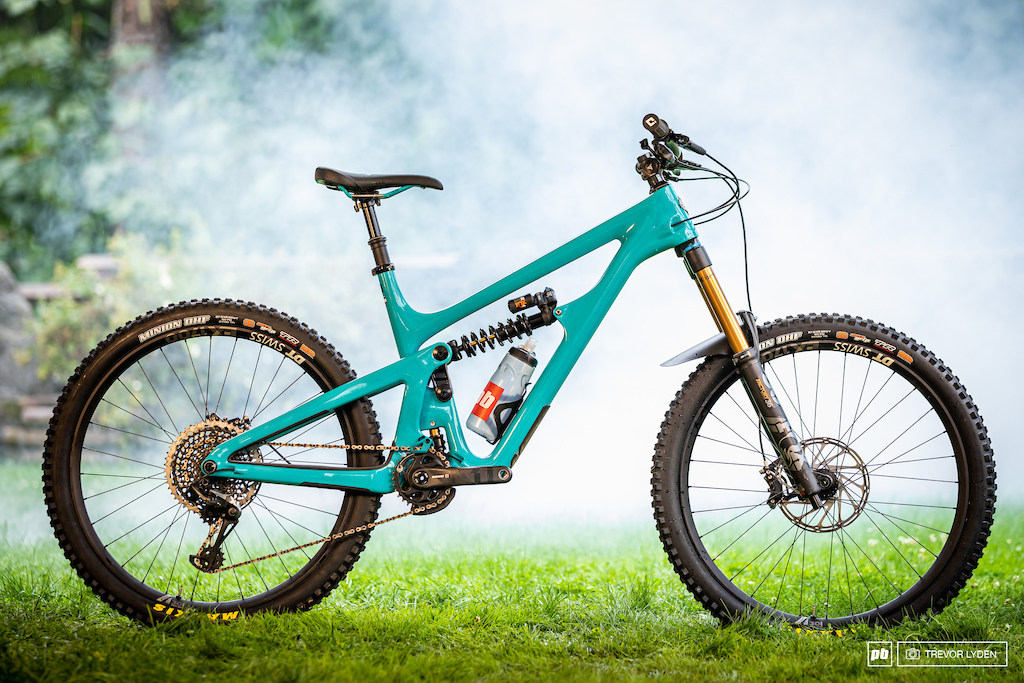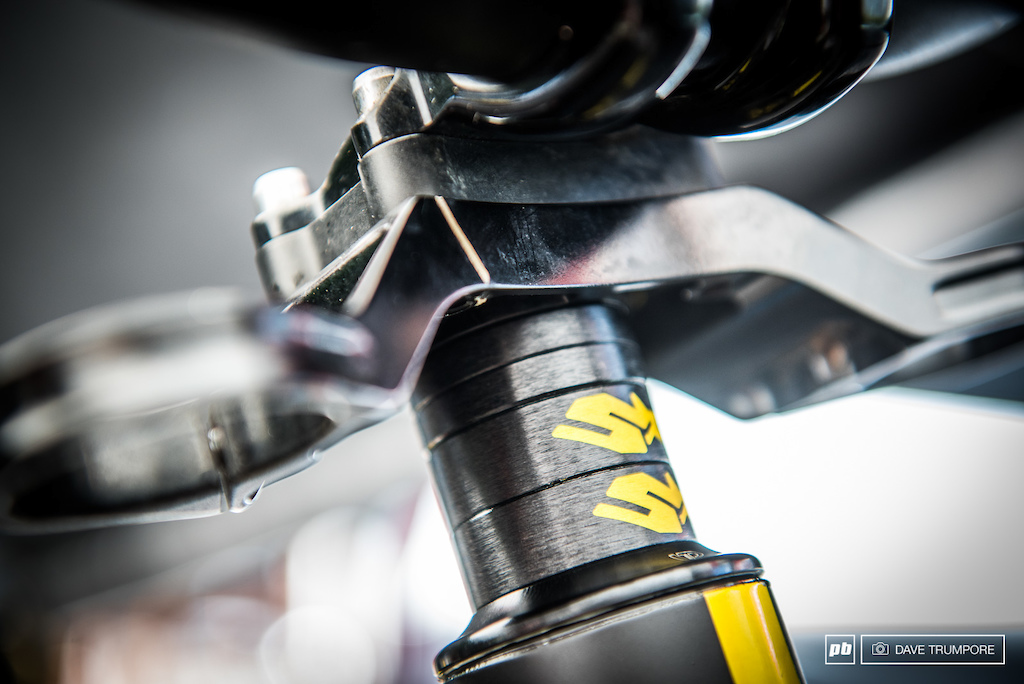Here at Pinkbike, we get inundated with all kinds of questions, ranging from the basic "Can I have stickers" to more in-depth, soul-searching types of queries like if you should pop the question or what to name your first child. Ask Pinkbike is an occasional column where we'll be hand-picking and answering questions that have been keeping readers up at night, although we'll likely steer clear of those last two and keep it more tech oriented.
Coil Shock Climbing Perfomance?Question: @alaskarider89 asks in the
All Mountain, Enduro & Cross-Country Forum:
for people that have swapped from air to coil on an AM bike (140-160 rear travel), wondering how much it affected your bike's climbing and how hard it was to set up properly to maintain a good climb? Thanks! |
The trade-off that usually accompanies making the switch to a coil shock is a little more suspension motion when you're grinding up a steep climb. The good news is that you'll also be gaining additional traction due to the increased sensitivity, which will make it easier to get through those chunky, technical climbs.
Many coil shocks have some sort of a climb switch, or at least a low-speed compression dial that you can use to firm things up for those long fire road grinds. How much motion there is while climbing will be dependent on your bike's suspension design, and on how much sag you're running. You may want to play with different spring rates to figure out which one gives you the feeling you're looking for while climbing and descending. I'd still aim for 25-30% sag, but you may find that you can run less sag with a coil shock than you did with air and still have plenty of comfort on the descents.
|
Reducing Palm Pressure?Question: @ovaltine1 asks in the
All Mountain, Enduro & Cross-Country Forum:
I recently bought a YT Jeffsy and was in-between sizes. I went for the larger one after recommendations from two YT employees (I called twice and they both recommended the larger size). I am super happy with the bike but I do feel ever so slightly stretched out, like there's too much pressure on my palms. It's not so much that I think its the wrong size bike but enough that I want to see what I can do about it. Any recommendations? My first thought was shorter stem and riser bars.  |
It sounds like you're on the right track – I'd start with a shorter stem and see if that helps. Even dropping from 50mm to a 40mm length can make a noticeable difference. You can also slide your seat forward in the rails to shorten up your cockpit a little more, and don't forget to check your stem spacer situation. If there are any spacers on top of the stem you can put them underneath to gain a little more height and reduce your reach.
Going with higher rise bars is a great idea too – I'm a fan of higher rise bars, even on trail bikes, and there are a bunch of really nice 30mm options currently on the market. That'll put you in a more upright position, and hopefully alleviate some of that hand pressure. |
120mm Bike For Enduro?Question: @ACurtin asks in the
All Mountain, Enduro & Cross-Country Forum:
I am wanting to try a couple of local enduro rounds (South West Kenda Enduro). But my only bike at the moment is a 120mm trail bike. So am worried I will be a bit underbiked for the trail, I much prefer the tech stuff and want to move more into that. But don't want to have to go out and buy a new bike before trying it? Would you recommend just giving it a shot? Or would it be too much for my bike?  |
All the footage I found of that enduro series looked extra-British – mud, rain, more mud, and some slippery, rooty tracks. I'd say that you'll be fine on your 120mm bike, especially if you're just testing the waters (no pun intended). I don't know what your current setup looks like, but at the very least I'd suggest putting on some aggressive tires to maximize the amount of grip and reduce the likelihood of getting a flat.
You may also want to think about increasing your fork travel if that's a possibility – a 120mm bike with a 140mm fork will give you a little more margin for error, along with giving you a slightly slacker head angle. With a Fox or RockShox fork an air spring is typically around $40, and the swap can easily be done by a semi-competent home mechanic. After you do a race or two you can re-evaluate your setup - seeing what other racers are using will give you an idea of what the ideal bike for your area might be.
|
Removing Float X2 Travel Spacer?Question: @BillyBoy0519 asks in the
Mechanic's Lounge:
I’ve recently purchased a 230 x 60mm Fox Float X2 and plan on changing it to 65. I’ve heard that the only difference is a travel limiter located on the shaft. Does anyone have any photos or experiences that they could share? I’m afraid I will remove the wrong spacer and mess up the shock.  |
You're correct, on a Float X2 the only difference between the 60mm, 65mm, and 62.5mm stroke lengths is the size of the travel spacer. However, removing that spacer isn't all that easy, and it requires some tools that you may not have. In the video below, at 2:57 you can see where the travel spacer will be – it sits above the bottom out bumper and accessing it requires removing the eyelet.
If you have all the necessary tools to ensure you won't end up scratching or crushing the shock it's not that difficult of a procedure. However, if anything in the first couple minutes of that video is outside of your comfort zone, I’d recommend taking your shock to a local shop to have them do the removal for you.
|





 Member since Feb 1, 2009
Member since Feb 1, 2009
There’s a hole, and then I eat the donut and the hole just vanishes...but I didn’t eat it!?
Is there a forum for real world questions on pinkbike?
Is there a forum for real bike questions on pinkbike?
And Linking Park replied: In the end, it doesn't even matter (if you eat it or not).
But:
Grim Donut: gone.
Slayer: gone
So there must be a substantial hole somewhere.
@hmstuna : Topology doesn't cut it here. This is downright quantum mechanics.
They're the best part of the donut!
Tumble dry.
Also, I recently heard about slick honey for suspension. Everyone seems to recomend it. Just pick the honey at your supermarket that has the lowest viscosity, and then pour some in your air spring. I also like to lube my cables with it.
Oh and linseed oil is the best chain lube....
Just curious what you feel would be the fastest. Gravel? 120mm XC? 140mm trail?
I'd say an enduro bike with fast-ish rolling tires, and lockout would be the winner.
It's essentially what the BC Bike Race is x 7, downcountry bikes killed it....
There are misconceptions about climbing with a coil spring. Because a coil is (usually) linear, you would set up a coil with a little less sag than an air shock on the same bike with the same link. This does three things:
• The bike sits a bit higher with the coil, helping your ergonomics.
• By sitting higher in the travel, the suspension remains in a region of higher pedaling anti-squat.
• Less friction means the suspension is less likely to hang up on tiny impacts. It also means the bike is more likely to bob due to tiny forces. My perception is the two effects roughly cancel out.
• Wheel: You can reduce the force through reduced low-speed compression damping and lower tire pressure. You can also sit farther forward to reduce weight on the rear wheel.
• Kickback: Not a lot you can do. Larger chainring to reduce anti-squat.
The real solution is to go faster. The slower you go, the less efficient, which makes you slower yet. No one said this sport was easy or fair! When you travel very slowly, the chassis and your centre of mass track the ground, including every little rock and root. When you go quickly, only your tire tracks the ground while casing flex absorbs some roughness, meaning the wheel doesn't need to fully track the ground, and - most importantly - the chassis and your body (the primary masses) only need to track the general contours of the trail, not every little bit of roughness.
A related problem: at slow speeds, as your whole mass sinks into the contours of the trail, you need enough torque to climb up and over trail roughness. For example, if you go over a root slowly, you need enough torque to lift yourself over the momentarily steep profile of the root. If you're traveling quickly, you need only enough torque to maintain your speed - the tire and suspension will absorb the root without you having to lift yourself over it - plus restore the energy lost through tire flex and suspension damping.
The cruel reality is, for a given amount of leg force available, you have two possible speeds at which you can travel, with a gap between them that would require more force than is available. If you don't have quite enough force to sustain the higher speed, at which the suspension is saving you from a lot of unnecessary lifting, you have no option but to drop to the lower speed. It's a non-linear relationship in which a little more leg strength can produce a lot more speed. The best approach on rough terrain is to rest where it's smooth and really give it through the roughest sections.
Most, if not all, of us have experienced how a fully-rigid bike hangs up on everything and is much slower than a suspended chassis when passively coasting through rough terrain. We know suspension can be faster, so we ought to know that reducing suspension function via a climb switch can be slower than leaving the damper open. We also know fully-rigid bikes are more efficient on smooth terrain (ex. road bikes), so there must be specific conditions that trigger this tipping point.
The combination of speed, roughness, hardware (tires, suspension design, etc.), and rider inputs will determine whether the climb switch is helping or hurting efficiency.
You're only losing efficiency if you are bouncing up and down on the bike while pedaling. Just sit and spin, and look at how much your bike moves, it barely does. Maybe using 5mm of travel?
I'm on a coil sprung 170mm E29.
While I still prefer a hardtail for XC racing, which goes against popular opinion, the big bike keeps the suspension active, and definitely climbs tech better that way.
To give an idea of how much I value a climb switch, I opted for a shock without a switch, even though it was the same price and the switch would've been easily accessible on my bike.
As I've realised and well stated by R-M-R - speed is your friend. Speed, center weight light hands and heavy feet heals down and I go through much that used to stall me out. I would assume coil rear would be similar to the MegNeg with the climb switch on (off the top of ones travel).
My suggestion as someone who spends a lot of time on the tools working with small machines, and also broken wrists in the past so has pain as well RSI, is get decent grips which will help with pressure points. My preference is ODI Pro, Ergon GE-1 is also nice, what I look for is palm support, a curve upwards (concave?) where your palm is rather than a flat grip helped a lot. For me anyways.
The shape of the grips is best described by “convex,” as concave is like a dent, where convex is like a bubble.
That said, I am looking to fit a 130/140mm Pike just to make things a little smoother.
Is it just that sponsored riders are not allowed too?
Axle paths: www.pinkbike.com/photo/17036509
But yeah, the bigger deal of course here is, just ride your damn bike! There have always been people riding the Megavalanche on hardtails, how would a whopping 120mm be insufficient for enduro racing? If you need to ride slower because of this, you only have longer to enjoy the ride
www.ridefox.com/fox17/help.php?m=bike&id=978
So if you build up a custom super burly 120mm travel bike race it!! Everyone at a dh race who sees a trail bike cheers them on like maniacs haha